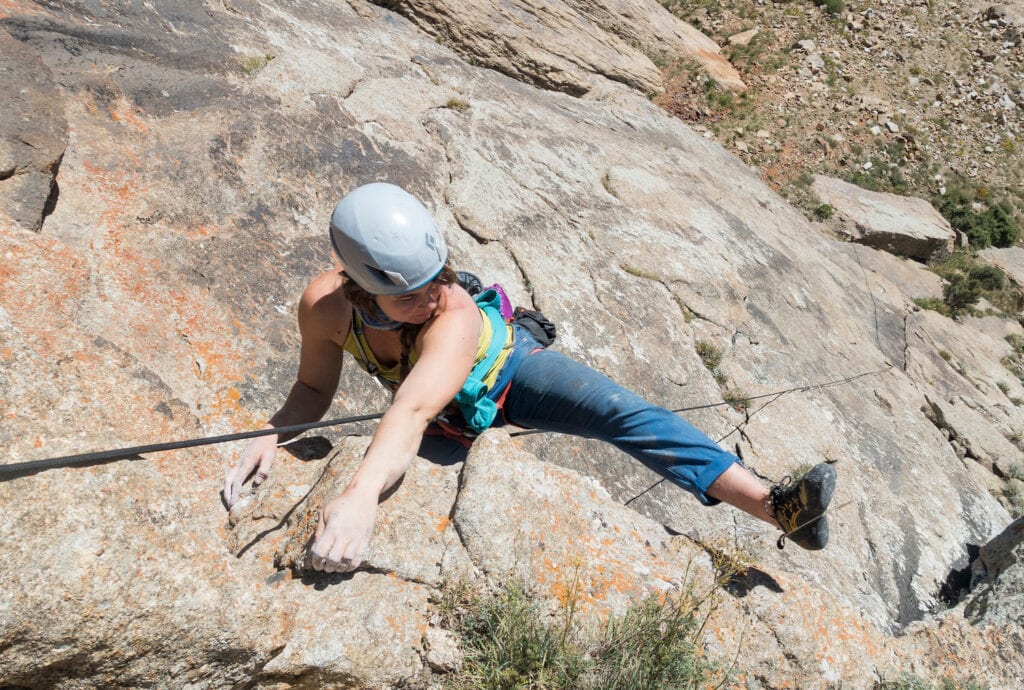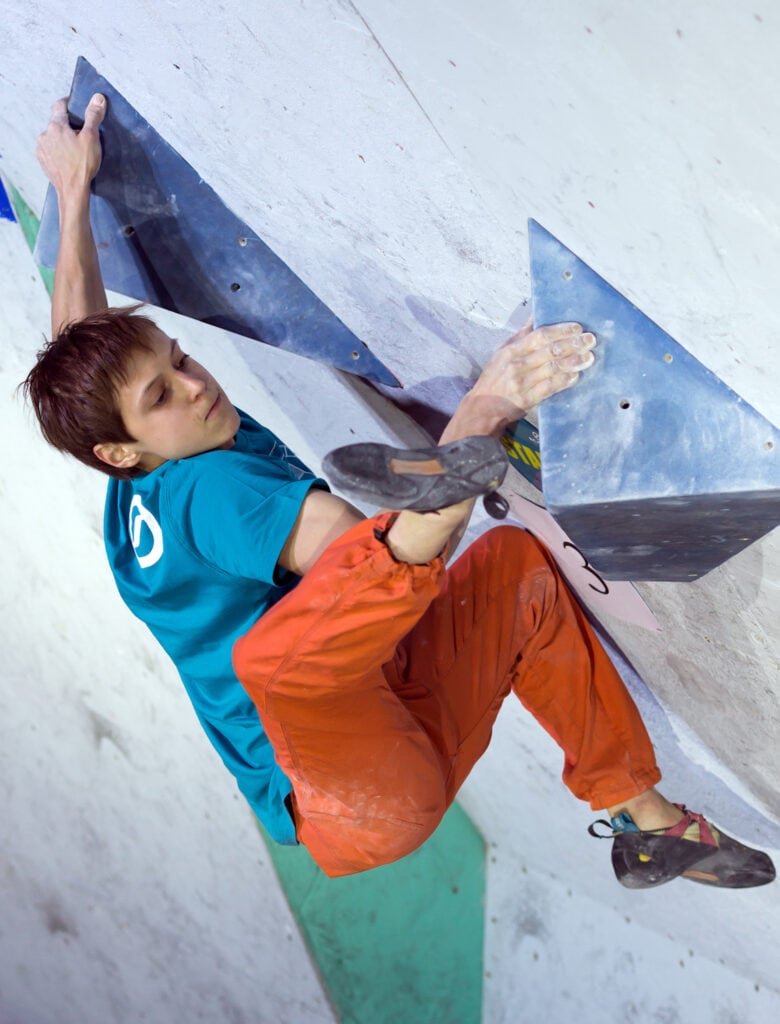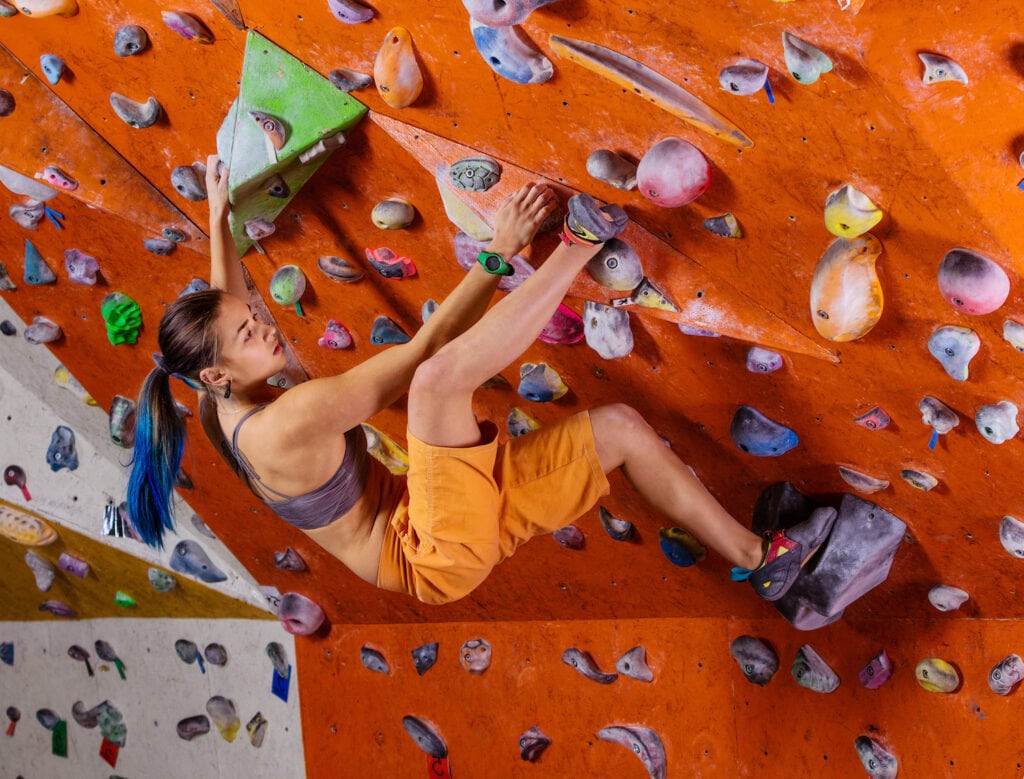Heel Hook (Climbing Technique): The Key to Your Next Level!

Published on: 11/16/2022
What’s a heel hook?
Definition
When it comes to footwork in rock climbing, heel hooking is one of the most common climbing techniques for the intermediate and advanced levels.
And no, we’re not talking about the heel hook in Brazilian Jiu-Jitsu used to tackle your opponents or other climbers at the crag who are flashing your project.
The heel hook is a move in climbing where you place your foot on a hold or ledge and apply pressure with the heel of your climbing shoe.
This allows you to pull with your leg muscles to draw yourself close to the wall, achieve a stable body position, rest, shift your body weight, and even generate force for your next move.

Origin in Rock Climbing
The heel hook technique was first used in the 50s, most famously by British rock climbers like Don Whillans, Joe Brown, and Chris Bonington. Back then, the heel hook was used more for taking a break, simply letting the other leg dangle and shaking out one arm or the other to rest.
This is still a very widespread rest position in climbing, but it’s also so much more by now. Since the beginning, heel hooking has evolved into a much more complex technique for climbers.
Nowadays, you can use the heel hook to climb routes and boulders indoors and outdoors, making tough grades feel easier than when they were first opened. In the process, heel hooking has become an inseparable part of modern bouldering and sport climbing.
Why Is Heel Hooking Important
Purpose of the Heel Hook
A good heel hook is a powerful climbing technique that helps you overcome difficult passages on the climbing wall or rock. The better your legs are trained, and the better you master this technique, the more leverage you will have when climbing.
Some even say that a heel hook is like a third arm, allowing you to pull harder with your arms for your next move. That’s especially true in steep terrain like overhangs or on traverses, where the heel hook allows for more balance and stability.
Often, heel hooking will even be the only option to get past the crux in bouldering or rock climbing. Particularly in mantle climbing, heel hooks are often an inevitable and crucial technique to master.

Which Climbing Types Use Heel Hooks
Virtually all types of rock climbing or indoor climbing will call for a good heel hook technique.
Many climbers neglect good footwork and rely too much on their arms, pulling too hard. But that’s not smart in terms of effectiveness. Heel hooks make your climbing more energy-efficient, technical, and proficient as they give you a bigger range of motion and more individual beta options.
Therefore, climbing shoes for bouldering and sport climbing have also evolved, and more emphasis is now placed on the heel of climbing shoes. Good rubber and the engineered heel shape of the shoes allow for better pulling and don’t let you slip easily.
For many, the heel hook is a matter of personal preference – in fact, some feel more comfortable with a toe hook and use that technique more often on the climbing wall.
Depending on the body size and weight of climbers, as well as anatomical factors and conditioning, their climbing arsenal and body movement repertoire also vary. For some, a heel hook is the solution to almost every crux, while others will always try a toe hook first.
Either way, learning this climbing technique will help you advance as a climber and master more difficult routes and problems over time.
How to Use the Heel Hook
Heel hook climbing mobilizes all the muscles in the legs while taking the weight off the hands, arms, and shoulders.
However, in order to properly unload your arms and upper body and pull with your leg, you need to find a good position, apply the right tension and rely on your shoes.
To use a heel hook, you need to pay attention to several key elements: Heel placement, toe/foot alignment, hip, and body position.
Comprehensive Step-by-Step-Guide to Heel Hook Climbing
- Take the starting position with one leg engaged and ready to go and the other foot on a lower hold or suspended in the air.
- Place the lateral side of your heel at waist level on the target hold or ledge.
- Make sure to have your toe pointing down as far as possible – this creates a literal “hook” that locks your foot in place.
- Start pushing off with your lower leg to gain height and shift your body weight in the direction you want to go.
- Tighten your core muscles, calves, hamstrings, and glutes to keep your hips and torso close to the wall – making your movement more precise.
- Release one arm and grab the next grip. Pull yourself over the hip line and slowly release the pressure from your foot.
- At this point, you may want to switch from heel to toe to stand up – otherwise, your range of motion above the hip is naturally limited.



Which Climbing Holds Are Good for Heel Hooks?
You can heel hook literally any climbing hold in the gym or outdoors on real rock, as long as you have appropriate shoes and good technique. Here are a few examples:
Jugs
This is a no-brainer – a jug will be the best possible hold to put a heel hook on because the risk of slipping is very low. On the other hand, be careful, as some heel hooks are so good your foot might get stuck there. Be sure to have a controlled position at all times so you can pull your foot out of there if you
Volumes
Volumes, shapes, structures, elements, triangles – whatever you call them where you’re from, they’re amazing for heel hook climbing. Typically, volumes offer a lot of contact area with amazing grip, so you can literally throw your heel blindly onto it, and the rubber will stick.
Smearing hooks but also foot jams, and toe-heel cams are frequent foot placements when hooking on volumes.

Slopers
Similarly to volumes, slopers offer significant surface area and acceptable friction. A slippery and smooth sloper under your palms can be just an ideal surface to place your heel stably.
Crimps
Tiny, sharp, incut – maybe crimps aren’t necessarily what comes to mind when you think of a heel hook. And yet, because of their protruding edges, crimps can be great for pinpointing a pressure point with your heel and applying force with precision.
Advice from Professional Climbers and Coaches
1. Maximize Surface Contact
Pro climbers and coaches alike will tell you to maximize surface contact between your shoe and the climbing hold. That’s because a larger surface area offers more friction, and more friction means better force distribution and less risk of slipping.
2. Oswaldo Zuniga (Rockentry)
3. Maximize the Use of Your Shoes
The heel of a climbing shoe usually has edges, too, so you can really dig into little crimps instead of smearing with the rubber surface. For this type of heel hook, you want to rotate your knee and ankle out and place your heel sideways on the hold, so the edge is locked into the crimp.
4. Hips to the Wall!
As with many other climbing techniques, the heel hook works best when you keep your pelvis closer to the wall. This allows you to use your strength more precisely and not waste energy holding on solely with your fingers and forearms.
5. Lattice Training: Fundamentals Series
6. Pull and Push
A smooth transition from pulling to pushing is important for the control of the whole movement. Too early or too late is no good – choose the moment when your balance and stability are optimal for the transition.
7. Heel hook placement changes your hinge
Hooper’s Beta: Anatomy of the Climb (extract):
Tips to Practice Heel Hooks
Requirements
It’s become obvious by now that strong, and well-developed leg muscles are essential for a proper heel hook. Especially your hamstrings need to be in good shape, not only to let you move well but also to prevent injury.
Upper body strength is also important when pulling upwards, locking off, or generating explosive momentum to grab a far hold.
Paying close attention to your heel hook position (especially when followed by a dynamic move) will potentially spare you a bunch of failed attempts. So good proprioception is key – a.k.a. the sense allowing us to feel and coordinate our body parts in space subconsciously.
Last but not least, an important requirement is to have good climbing shoes with clean rubber. The quality of the hold you heel hook on matters too, so remember to brush your holds and avoid using wet or sandy spots.

How to Stay Safe at All Times
When attempting this crucial technique, all about proper positioning to stay safe. In addition to powerful leg muscles, make sure to apply constant pressure to the heel and rotate the toe as needed. Otherwise, your heel will just slip.
The greatest danger when heel hooking is when your heel slips off in mid-motion. The sudden strain on your hands and arms can cause you to fly off the wall unexpectedly and uncontrollably.
High heel hooks pose a particularly high risk because the swing may be too large to hold up. Especially if your back and head are exposed to the potential fall, you should always have a spotter or two with you when heel hooking.

Pitfalls to Avoid
Applying the heel hook can take the load off your arms, but loading the hamstrings too much can quickly result in hurting yourself. Beginner climbers especially risk injuries if they aren’t careful when using heel hooks.
In order to avoid injury, it’s best to start by including strength training in your routine. Targeted leg exercises like hamstring curls, as well as stretching the hamstrings, can prevent injuries to the thigh muscles and tendons in the knees.
Maintaining body tension is another important part of good heel hooking. So work on your core and abs to make sure your whole body is involved in the movement. This will take pressure off your joints and ligaments while activating your muscles.
Another pitfall to avoid is dirt and debris on your climbing shoes, which can cause you to slip. Make sure the rubber on your shoes is clean and free of holes so you can maximize the surface of contact with where you put your heel.
Final thoughts
So there you have it. If you ever wished you had a third arm when climbing, a heel hook might just be what you need. The heel hook is the most versatile, creative, and proficient of all climbing techniques. It definitely pays off to practice it to perfection.




